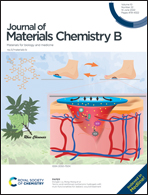Preparation and characterization of biomimetic gradient multi-layer cell-laden scaffolds for osteochondral integrated repair
Abstract
A cell-laden tissue engineering scaffold for osteochondral integrated repair is one of the ideal strategies for osteochondral lesions. In this study, we fabricated cell-laden porous hydrogel scaffolds with gradient nano-hydroxyapatite using methacrylic anhydride gelatin (GelMA), nano-hydroxyapatite (nHA), and polyethylene oxide (PEO) solution for osteochondral tissue regeneration. The scaffold possessed interconnected pores and a nano-hydroxyapatite gradient in the vertical direction. The chemical, physical, mechanical, and biological properties of the hydrogel solutions and scaffolds were characterized. In vitro experiments confirmed that cells were distributed homogeneously and that different pore structures could affect the proliferation and differentiation of BMSCs. The Nonporous hydrogel was beneficial for the chondrogenic differentiation of BMSCs and interconnected pores were conducive to BMSC proliferation and osteogenic differentiation. The osteochondral integrative repair capacity of the scaffold was assessed by implanting the scaffolds into the intercondylar defect of the rabbit femur. By constructing pore structures in different layers, the cells in different layers of the hydrogels were in an intrinsic environment for survival and differentiation. Animal experiments confirmed that tissue engineering scaffolds for osteochondral lesions require different pore structures in different layers, and gradient structure facilitated integrated repair.



 Please wait while we load your content...
Please wait while we load your content...